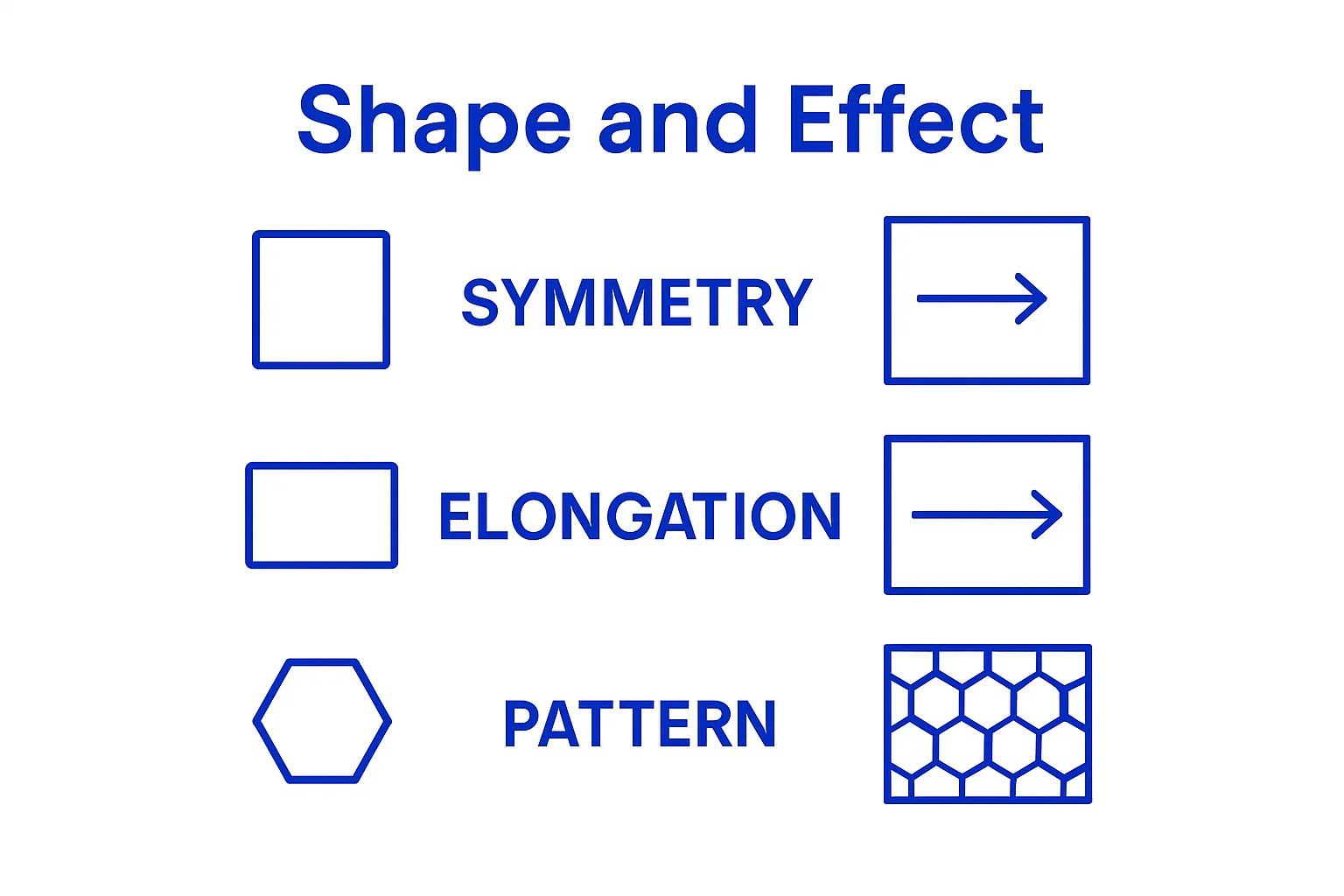Understanding Tile Shapes Explained for Design Choices
Posted by Mike Belk on Oct 06, 2025

Tile shapes might seem like a simple choice at first, but they hold surprising power over how a space looks and feels. While most people focus on color or material, the geometry of your tiles can actually influence perception and mood in ways you might not expect. For example, elongated rectangular tiles can make a small room feel much larger and more open. The real secret is that these shapes do more than decorate. They reshape the way you experience any room.
Table of Contents
- What Are Tile Shapes And Their Importance?
- The Different Types Of Tile Shapes Available
- How Tile Shapes Influence Design Aesthetics
- Practical Applications Of Various Tile Shapes
- Understanding The Relationship Between Tile Shapes And Space
Quick Summary
| Takeaway | Explanation |
|---|---|
| Tile shapes influence spatial perception significantly. | Different tile geometries can make rooms look larger or smaller. For example, elongated tiles can widen narrow rooms visually. |
| Classic shapes remain essential for design foundational. | Square and rectangular tiles are versatile and reliable, providing symmetry and elongation options in various spaces. |
| Contemporary shapes enhance creative expression. | Non-traditional shapes like hexagons and irregular forms allow for innovative design, creating unique visual narratives within a space. |
| Tile selection should consider functional performance. | The choice of tile shape affects installation complexity and can enhance usability, especially in specialized environments like kitchens and bathrooms. |
| Psychological impacts of tile shapes matter. | Different geometries evoke varied emotional responses, influencing how individuals feel in a space—angular shapes add energy, while curved forms promote comfort. |
What Are Tile Shapes and Their Importance?
Tile shapes represent far more than simple geometric configurations in interior design. They are critical visual elements that dramatically influence spatial perception, aesthetic appeal, and functional performance across residential and commercial environments. Explore the nuanced world of tile design trends to understand how these fundamental design components transform spaces.
The Fundamental Geometry of Tile Design
At their core, tile shapes are geometric forms that serve both decorative and practical purposes. Traditional tile shapes like squares, rectangles, and hexagons have long been staples in architectural design, each offering unique visual characteristics and installation possibilities. Contemporary design has expanded these options, introducing unconventional shapes that challenge traditional boundaries and create dynamic visual narratives.
Key considerations for tile shapes include:
- Spatial perception and visual flow
- Installation complexity and pattern potential
- Room size and architectural context
- Design aesthetic and mood creation
Psychological and Visual Impact of Tile Shapes
The shape of tiles goes beyond mere aesthetic preference. According to architectural design research, different tile geometries can fundamentally alter how we perceive and experience interior spaces. Elongated rectangular tiles can make rooms appear larger and more expansive, while intricate hexagonal patterns can create visual complexity and depth.
Square tiles offer symmetry and predictability, ideal for creating calm, structured environments. Triangular and irregular shapes introduce dynamism and movement, perfect for contemporary spaces seeking to challenge conventional design norms. By strategically selecting tile shapes, designers can manipulate spatial perception, create focal points, and guide visual attention within a room.
This table describes how different tile shapes and configurations impact both the perception of space and the psychological experience within a room.
| Tile Shape/Configuration | Impact on Space Perception | Psychological/Emotional Effect |
|---|---|---|
| Elongated Rectangular | Makes rooms appear larger/wider | Sense of openness and expansion |
| Square | Creates symmetry and order | Promotes calm and structure |
| Hexagonal | Adds visual complexity and depth | Evokes energy and curiosity |
| Triangular/Irregular | Introduces movement and dynamism | Generates excitement and modernity |
| Curved/Circular | Softens room edges | Encourages comfort and relaxation |
| Large Format | Reduces visual fragmentation | Suggests minimalism and sophistication |
| Small Mosaic | Adds intricate texture | Creates visual interest and detail |
Understanding tile shapes means recognizing them as powerful design tools that transcend mere surface covering. They are instrumental in crafting environments that are not just visually appealing but psychologically engaging, transforming ordinary spaces into extraordinary experiences.
The Different Types of Tile Shapes Available
Tile shapes have evolved dramatically from traditional geometric configurations, offering designers and homeowners unprecedented creative possibilities. Learn how to use different glass tile backsplash shapes to accentuate your home and understand the transformative power of innovative tile geometries.
Classic Geometric Tile Shapes
Traditional tile shapes remain foundational in design, providing reliable and versatile options for various spaces. The most prevalent geometric shapes include:
- Square tiles: Perfect for uniform, structured layouts
- Rectangle tiles: Ideal for creating visual elongation and movement
- Hexagonal tiles: Offering intricate pattern potential
- Circular tiles: Introducing softness and organic flow
Each classic shape brings unique visual characteristics that can dramatically alter a space’s aesthetic and perceived dimensions.
Below is a comparison table of classic geometric tile shapes, highlighting their distinctive features and the design effects they commonly produce.
| Tile Shape | Visual Characteristic | Design Effect |
|---|---|---|
| Square | Symmetry and uniformity | Creates balance and predictability |
| Rectangle | Elongation and movement | Visually expands or lengthens space |
| Hexagonal | Intricate patterning | Adds complexity and modernity |
| Circular | Organic flow and softness | Introduces comfort and gentle curves |
| Mosaic (Small) | Detailed and flexible | Enables intricate designs and coverage |
 Rectangular tiles, for instance, can make narrow rooms appear wider, while square tiles create a sense of balance and symmetry.
Rectangular tiles, for instance, can make narrow rooms appear wider, while square tiles create a sense of balance and symmetry.
Contemporary and Unconventional Tile Shapes
Modern design has pushed boundaries by introducing increasingly complex and imaginative tile shapes. According to architectural design research, emerging tile geometries challenge traditional design norms. Designers now experiment with:
- Arabesque and moroccan-inspired curved shapes
- Triangular and diamond configurations
- Irregular, fragmented geometric forms
- Elongated subway and metro tile variations
These innovative shapes allow for unprecedented creative expression, enabling designers to craft unique visual narratives that transcend conventional surface treatments. Asymmetrical and non-traditional shapes introduce dynamism and visual intrigue, transforming floors, walls, and backsplashes into artistic statements.
Functional Considerations in Tile Shape Selection
Beyond aesthetic appeal, tile shapes must also consider practical installation requirements and spatial constraints. Larger format tiles can reduce grout lines and create seamless appearances, while smaller mosaic tiles offer intricate detailing and flexibility in complex architectural environments. The choice of tile shape should harmonize with room dimensions, lighting conditions, and overall design intent, ensuring both visual impact and functional performance.
How Tile Shapes Influence Design Aesthetics
Tile shapes are powerful visual storytellers that go far beyond surface decoration, fundamentally transforming spatial experiences and emotional responses within interior environments. Discover how tile patterns play a critical role in design, exploring the nuanced ways geometric configurations shape our perception of space.
Psychological Impact of Geometric Configurations
The geometric arrangement of tiles creates profound psychological responses that subtly manipulate spatial perception. Different tile shapes communicate distinct emotional narratives through their inherent visual characteristics. Angular shapes like triangles and hexagons introduce dynamic energy and movement, while soft, curved configurations generate feelings of comfort and fluidity.
Key psychological design principles include:
- Creating visual tension through geometric contrast
- Establishing rhythmic visual patterns
- Guiding viewer attention through strategic shape placement
- Generating emotional responses through geometric complexity
Spatial Transformation Through Tile Geometry
According to architectural design research, tile shapes possess remarkable capabilities to manipulate perceived room dimensions and architectural character. Elongated rectangular tiles can visually expand narrow spaces, making rooms appear broader and more spacious. Conversely, small mosaic tiles create intricate textural landscapes that draw viewers into detailed visual experiences.
Complex geometric arrangements challenge traditional spatial boundaries, transforming walls and floors from passive surfaces into active design elements. Hexagonal tiles, for instance, create honeycomb-like patterns that introduce mathematical precision and organic complexity simultaneously.
Strategic Design Considerations
Selecting tile shapes requires careful consideration of architectural context, lighting conditions, and intended emotional atmosphere. Large-format tiles with minimal grout lines suggest contemporary minimalism, while intricate mosaic configurations communicate craftsmanship and artistic complexity. The strategic selection of tile shapes allows designers to craft immersive environments that transcend mere functional surface coverings, becoming integral components of holistic spatial narratives.

Practical Applications of Various Tile Shapes
Tile shapes transcend aesthetic considerations, serving critical functional roles across residential and commercial environments. Explore how tile patterns and designs can elevate your home’s aesthetics to understand the strategic potential of thoughtful geometric selection.
Spatial Optimization and Room Perception
Different tile shapes offer remarkable capabilities for manipulating spatial perception and architectural dynamics. Rectangular tiles laid horizontally can visually expand narrow rooms, creating an illusion of increased width. Conversely, vertically oriented tiles draw the eye upward, making ceiling heights appear more generous. This geometric manipulation allows designers to address architectural limitations through strategic tile shape selection.
Practical spatial optimization strategies include:
- Using elongated tiles to create visual expansion
- Implementing diagonal layouts to introduce dynamic movement
- Selecting larger format tiles to reduce visual fragmentation
- Matching tile shape to room proportions and architectural context
Functional Performance in Specialized Environments
According to national preservation standards, certain tile shapes demonstrate superior performance in specific environments. Hexagonal and penny-round tiles excel in wet areas like bathrooms and kitchens, offering enhanced slip resistance and superior drainage capabilities. Their interlocking configurations create more secure surface treatments that prioritize both safety and aesthetic appeal.
Small mosaic tiles provide exceptional flexibility in complex architectural spaces, enabling seamless coverage around curves, corners, and irregular surfaces. Their miniature scale allows for intricate detailing and precise adaptations that larger tile formats cannot accommodate.
Design Versatility and Contextual Integration
Tile shapes function as dynamic design elements that communicate architectural intent and spatial character. Geometric configurations can signal design narratives ranging from minimalist precision to organic complexity. Square tiles suggest structured formality, while irregular fragmented shapes introduce contemporary dynamism. The strategic selection of tile shapes allows designers to craft environments that seamlessly integrate functional requirements with expressive visual language, transforming surfaces from passive coverings into active design statements.
Understanding the Relationship Between Tile Shapes and Space
Tile shapes possess an extraordinary ability to manipulate spatial perception, transforming architectural environments through strategic geometric configurations. Discover how tile patterns define your space and unlock the visual potential of thoughtful tile selection.
Dimensional Manipulation Through Geometric Configurations
Tile shapes function as powerful visual tools that can dramatically alter perceived room dimensions and architectural character. Elongated rectangular tiles, when positioned horizontally, create an illusion of expanded width, making narrow spaces appear more generous. Vertical orientation of the same tiles can visually heighten ceiling perceptions, introducing a sense of verticality and openness.
Key spatial transformation strategies include:
- Utilizing directional tile layouts to influence perceived room proportions
- Selecting tile sizes that complement architectural dimensions
- Creating visual flow through consistent geometric configurations
- Balancing tile scale with room volume and natural lighting
Psychological Perception of Spatial Geometry
According to preservation architectural standards, tile shapes communicate complex spatial narratives beyond mere surface coverage. Intricate geometric configurations like hexagonal or mosaic tiles introduce visual complexity that engages viewers, creating spaces that feel dynamic and intellectually stimulating. Conversely, large format square tiles suggest minimalist precision, generating feelings of calm and structured simplicity.
The interplay between tile shape and spatial perception extends beyond visual mechanics. Different geometric configurations trigger subtle psychological responses, influencing how individuals emotionally experience architectural environments. Angular shapes introduce energy and dynamism, while softer, curved configurations generate feelings of comfort and fluidity.
Strategic Design Considerations
Designers must approach tile shape selection as a nuanced art form, carefully considering architectural context, lighting conditions, and intended emotional atmosphere. Small tiles create intricate textural landscapes that draw viewers into detailed visual experiences, while larger format tiles suggest contemporary sophistication with minimal visual interruption. The strategic selection of tile shapes transforms surfaces from passive coverings into active design elements that narrate architectural stories, bridging functional requirements with expressive visual language.
Transform Your Design Vision Into Reality With BELK Tile
Are you feeling overwhelmed by the countless tile shapes available and unsure how each choice will affect the look and feel of your space? Choosing the right geometric configurations can deeply impact both aesthetics and function, as you discovered while learning how tile shapes influence spatial perception and create unique visual dynamics. BELK Tile makes it effortless to turn your understanding of tile geometry into personalized design solutions that fit your goals.
Experience a stress-free selection process with our wide inventory, organized by shape, color, and style. Whether you are looking to visually enlarge your kitchen with rectangular tiles or create textural depth in a bathroom using intricate mosaics, our extensive range of options empowers you to experiment without limits. Discover inspiring ideas, explore product details, and find specialty tiles for every project with ease. Visit BELK Tile today and let your new knowledge shape a space that feels just right. Shop now and move one step closer to a home or workspace that is as beautiful as it is functional.
Frequently Asked Questions
What are the common tile shapes used in design?
Common tile shapes in design include square, rectangular, hexagonal, and circular tiles. Each shape offers unique visual characteristics and installation possibilities, catering to various design aesthetics.
How do tile shapes affect the perception of space?
Tile shapes can dramatically influence how we perceive space. For instance, elongated rectangular tiles can make a room appear larger, while small mosaic tiles can create intricate detail and texture, enhancing visual interest.
What should I consider when selecting tile shapes for my project?
When choosing tile shapes, consider factors such as spatial perception, installation complexity, room size, architectural context, and the desired aesthetic mood. It’s important to harmonize tile shapes with the overall design intent and lighting conditions.
Can unconventional tile shapes be used effectively in design?
Yes, unconventional tile shapes like arabesque, triangular, and irregular forms can add dynamic visual interest to a space. These shapes allow designers to break traditional boundaries and create unique visual narratives that elevate the overall aesthetic.



